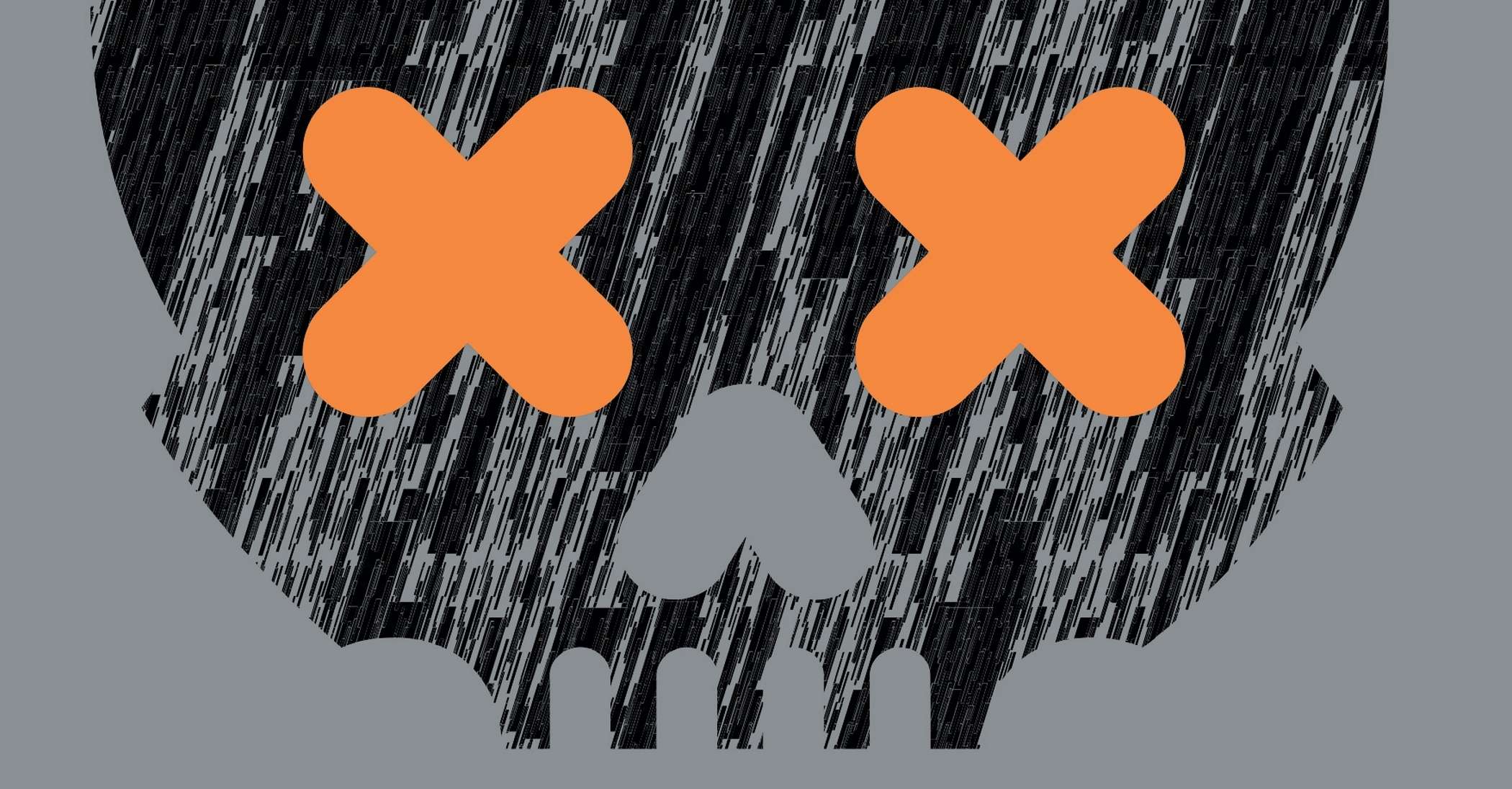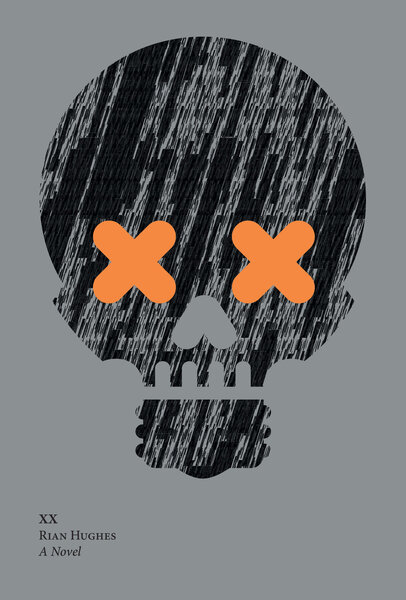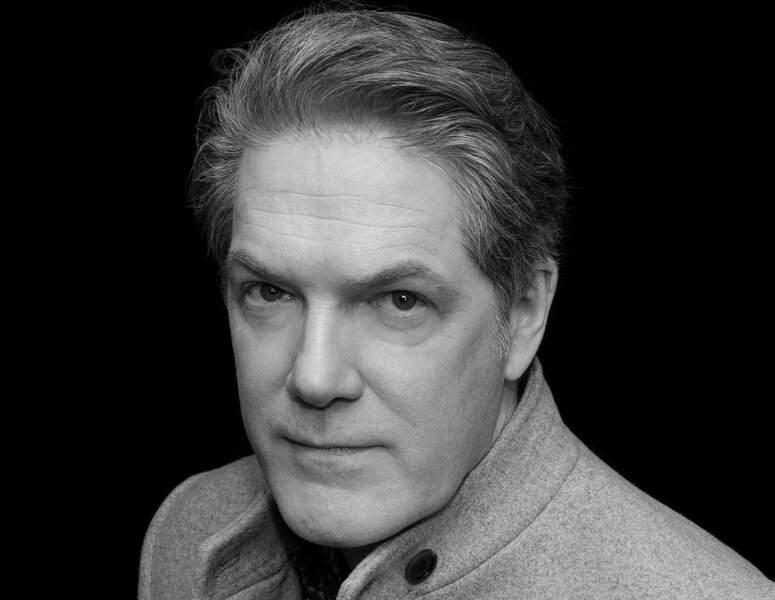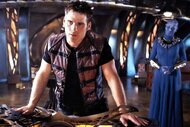Create a free profile to get unlimited access to exclusive videos, sweepstakes, and more!
Take a deep dive into the mysteries of Rian Hughes' massive new alien thriller novel, XX

Rian Hughes is one of the best known and most pervasive British illustrators and graphic designers of the past 30 years. Starting in the mid-1980s, Hughes contributed to influential titles like 2000 AD and Love and Rockets, while also doing work for DC Comics, collaborating with Grant Morrison on The Invisibles, and creating mastheads and logos for a number of other publishers. He expanded into the worlds of graphic design for advertising, books, album covers, and more, while also beginning (in 1992) to create his own custom fonts, which he now releases through his own company, Device Fonts.
Now he's written his first novel, XX, ostensibly a tale of humanity’s first contact with an alien intelligence through a transmission called the Signal. His main characters include a computer expert named Jack Fenwick, whose ability to see patterns in almost anything help him solve an important clue about the Signal, and Dana Normansson, an astrophysicist who physically encounters an object of unknown origin that has crashed on the Moon.
But XX is not your standard alien contact/invasion scenario. The nearly 1,000-page book incorporates a cascading array of typefaces and fonts, NASA transcripts, newspaper and magazine articles, fake Wikipedia pages, unknown alphabets, and even a pulp novelette by a fictional writer named Hershel Teague into an epic tale that questions the nature of reality and consciousness in a dizzying mash-up of language and design. XX is in many ways the next step forward from the now-classic House of Leaves, Mark Z. Danielewski’s 2000 novel that also manipulated text and content to create a disorienting, immersive experience.
SYFY WIRE spoke with Hughes via Zoom from his U.K. office about the genesis of XX and its development, his thoughts on the possibility of alien contact, and whether his mind-blowing book points the way for the future of the novel itself.
How did this all begin to formulate for you? I read that you were thinking about something along these lines for 20 years or more.
Yeah, there was an interview I gave in a design magazine probably about 20, 25 years ago now in which I talked about this and I never got around to doing it. Then I saw this magazine in an exhibition. It was a celebration of all the people who had been interviewed in this magazine, and there was this interview that I'd done. And I thought to myself, I should have done that. I must do that. So it has been bubbling under for that long.
Why was this stage of your career the right time finally?
I think it's the sum of a lot of things that I've been thinking of for a very long time. Being a graphic designer, a type designer, and a comic book artist, intimately involved with narrative and symbols and what things look like and what they mean. Color and shape and all those elementary aspects are pretty much the language of graphic design.
So I've been manipulating these symbols for a long time, but not in the service of a narrative. It's always been in the service of someone else's book cover, or a typeface, or a record sleeve, or a piece of advertising, or something like that. So moving it back toward authored design put me back to where I was when I was doing a lot of comic book work, where you are very much the author of your own material. You work with a writer all of the time, but you're not answering someone else's brief, you're creating something that is the thing in and of itself.
As a graphic designer, you're generally decorating someone else's idea, concept, product. You're not creating something that is the thing in and of itself. Which is what you do if you're a musician, or a fine artist, or a comic book artist, or a novel writer. People come to the work you produce because they want the work that you produce, not because it's clothing and decorating and packaging some other thing. So I wanted to create something where the graphic design was the thing. If that makes sense.
So sitting down and writing a straight novel was never on the agenda for you?
Never on the agenda, no. Although a lot of the novels that I've read when I was at that formative age, I've filtered through into it. So there's a bit of Arthur C. Clarke in there, transformative science fiction where you open up to the universe in this transcendental way, and where what we are as a human becomes so much larger. I mean, that's one of the themes of 2001, for example, or Rendezvous with Rama. So a lot of older obsessions and influences filter through into this as well.
Writing chapters of prose, and then knowing where to insert graphics, knowing when you wanted to change the type, knowing where you wanted to put the novel inside the novel — was that an intuitive process for you? Or was it something that you had to lay out?
Well, the way I did this was I wrote it directly into InDesign (a desktop publishing and typesetting software application produced by Adobe Systems). So I wrote it in the font that I was using...it looked how it sounded as I wrote it, if that makes sense.
I also used very short chapters, and each chapter had a specific point to make, but the final order of those chapters wasn't actually decided early on. And because it was in InDesign, I could shuffle them around quite easily...I could visually see where I color-coded all the various threads and elements. Then I could finally adjust them, as a piece of graphic design, right up to the 11th hour. I actually took out 350 pages of this. It's a heavy edit towards the end, mainly because I didn't want it to go over 1,000 pages because I just thought I was stretching the readers' patience enough as it was without going too far.
Were you surprised that you got to the point where you were endeavoring to keep it under 1,000 pages?
Yeah. There was no intention to write it that length. That's just how long the story took to tell. And most of what I excised was a subplot that, not that it wasn't relevant, it was just that the book could survive without it. So I took the whole thing out. And there were a lot of other peripheral articles and other inserts, these digressions that I had, that also got removed as well.
The idea of the alien signal actually being the alien intelligence itself, how does that jibe with your own ideas about what alien communication, if we ever experienced it, might be like? Do you think we're missing stuff out there?
I'm sure we are. One of the major themes of this book is how we define consciousness, and what forms that may take... I'm also fascinated by the way that ideas travel through human populations and how they are very much like viruses. You get a memetic head cold that will spread through social media or whatever. It can take decades to flush this from the human consciousness, because the arguments have to be won, one way or the other. The back and forth of human communication, I think, in some ways is analogous to the ways that we might turn over an idea in our minds and try and work out what the truth of the matter might be. So as a culture, I think we mirror quite a lot of the functions of a single human brain.
Do you think social media has accelerated that?
Yeah. I don't think there's anything mysterious about the way in which ideas are transmitted and how we pick them up. I think we're super sensitive to this. And this is the idea of Jack who has it almost to a debilitating degree — like apophenia, seeing meaning in things that might not have meaning, faces in clouds, things like that. This is the downside of this pattern-making aspect of the human brain, that we sometimes put things together and see patterns where there are none. I think that a lot of conspiracy theories come about because of this. We see a face on Mars when it's actually an outcrop of rock. We see a series of suggestive events laid out in time and think that there's some causal connection between them, the machinations of some dark and mysterious force — political or social elites that are pulling the strings behind this.
So I think we have a propensity to this kind of magical thinking. I think this is where gods came from, in early man. We would have a crop failure or the volcano would erupt, or we'd have a plague of locusts, and we would try and figure out why these were happening. It was a proto-science in a way, it's just that we didn't have the experimental method. All we had was our pattern making and storytelling, so this is where myths and legends and religions come from. I think that the way that modern obsessions with political ideas or social ideas, it's almost like a contagion sometimes in the way that they spread. And it is very, very similar to the way that religion or fads and fashions and these kinds of things spread, and always have spread. It's just that we have an electronic nervous system that just connects us much more directly now.
How do you think actual verified alien contact would affect this world today?
I discuss that in some of those fictional news clippings and interviews in XX. And in fact, those parts of the book have been some of the most popular parts. People love the parodies of Alex Jones conspiracy theorists on the one hand, and far-right meme makers. And then the far-left wokesters who blame humanity and think we deserve everything that's coming our way because of our imperialist radio broadcasts that we send out into the universe. So there have been people that have really enjoyed those parts of it. They're very much a commentary on the propagation of these wild ideas and how (alien contact) might feed into that.
I think that people assumed that a threat from outside would be this galvanizing force that would bring us all together. It's a thread of so many stories that some internal divisions are forgotten in the face of that much greater external threat. I'm not even sure that would happen. I think we're so divided in so many ways that when you look at something like COVID or global warming, these things that should be scientific discussions have become politicized. Science has become politicized in a way that I've never seen it become politicized ever before.
If you democratize the way that people can discuss science, the facts of the matter become lost in the opinions, and it's about how people feel rather than how things are. That's another theme of the book, the difference between the stories that we tell and the physical world that they inhabit. I play with those in a way that I have it both ways because the stories that we tell are in some ways analogous to consciousness and to the way that brains work. So on the one hand, I'm dealing with very scientific, factual, physical ideas. But on the other hand, I'm playing them off against the way that brains and consciousness and culture might work, and the interplay of the two.
Do you think the traditional idea of the novel needs to change?
Yeah. I think that the fact that the novels are laid out the way that they are, is a throwback to the limitations of print technology. Novelists would write a book on a typewriter, the manuscript would be set by someone else, a printer. It would probably have a limited number of fonts that he could use, maybe Times New Roman and Goudy, and a few other ones as dictated by the publisher probably. And then the book would come out. But I think that because layout programs and font design programs again, for better or worse, democratized all this, it's put back in the creator's hands, all of these aspects of making a novel that used to be outside of their hands.
Some of the fonts I designed specifically for this book using Glyphs, a great font design program. I used InDesign, I used Illustrator to lay out some of the more complicated pages, I used Photoshop to retouch some photographs. All of these things, which used to involve many, many, many different craftsmen, each with different skills, now all can be done by one person. So I think that we have, as creators, a much broader palette available to us in which to express ourselves. There, of course, have been historical examples of people using typography in a very expressive fashion before -- the Futurists, the Lettrists, concrete poetry -- but if there is something new in this, it's that it's in the service of an extended narrative where the writer has also been the graphic designer and the font designer.
I think there are more books coming out where the look and the layout of it are part of the experience. We have House of Leaves from a few years ago. J.J. Abrams' S. played a very similar conceit, where you have extra elements like postcards, and napkins tucked in the book. So maybe the time is right for this kind of novel. I think that I would like the average novel that doesn't really concern itself with typographic fireworks, to also be more aware of what it looks like on the page. Because the fonts that you use really do communicate in effect an atmosphere and a sense of how you approach something.
Could you see this book making the jump to film or television?
I certainly could. I would love that to happen. I think what you would need to do is find analogs to the things I've played with in the book. So, if it was a TV show for example, the Ascension story, which is laid out and written like a 1950s, 1960s pulp story, might be presented as a short interlude in black and white as if it was an episode from something like The Outer Limits or The Twilight Zone. So you would find ways to mirror, visually, the literary devices that I've used.
This interview has been edited for length and clarity. XX is out now in bookstores and from digital retailers.




























